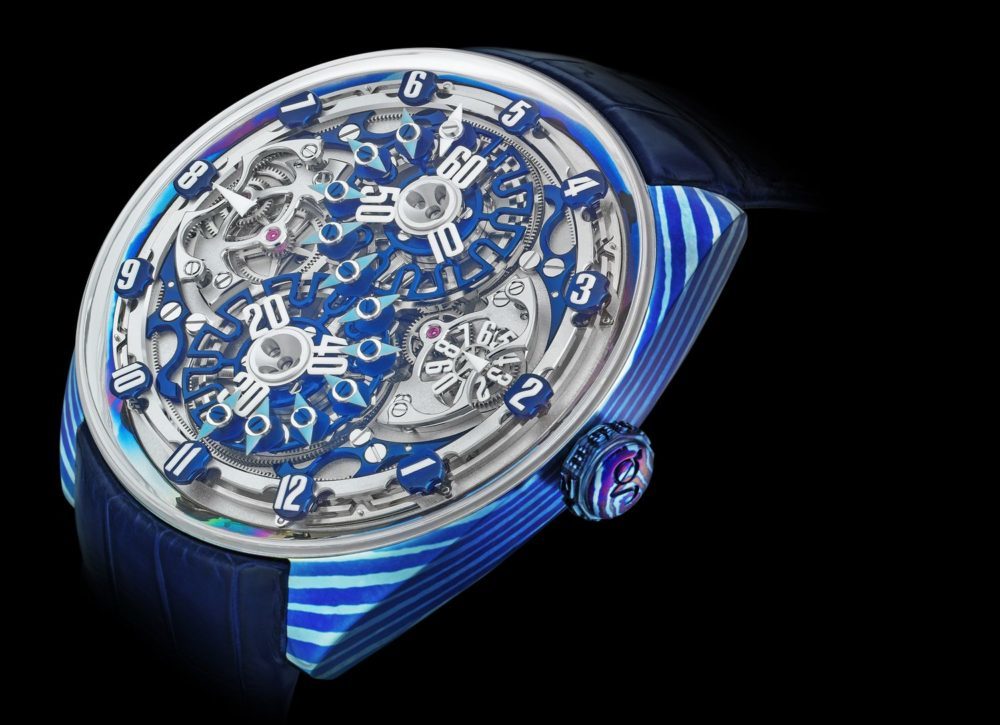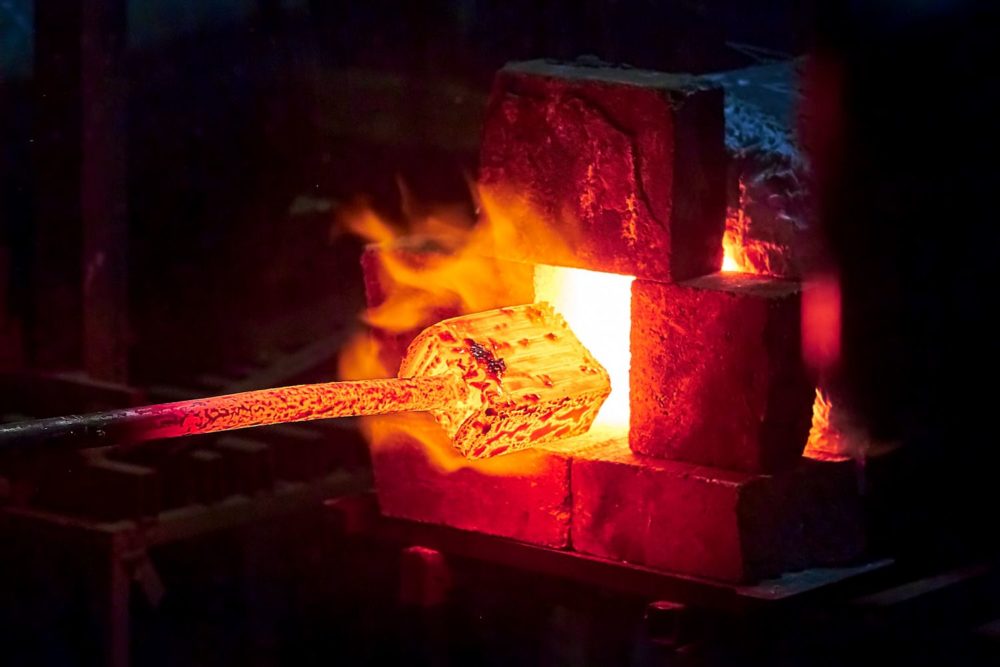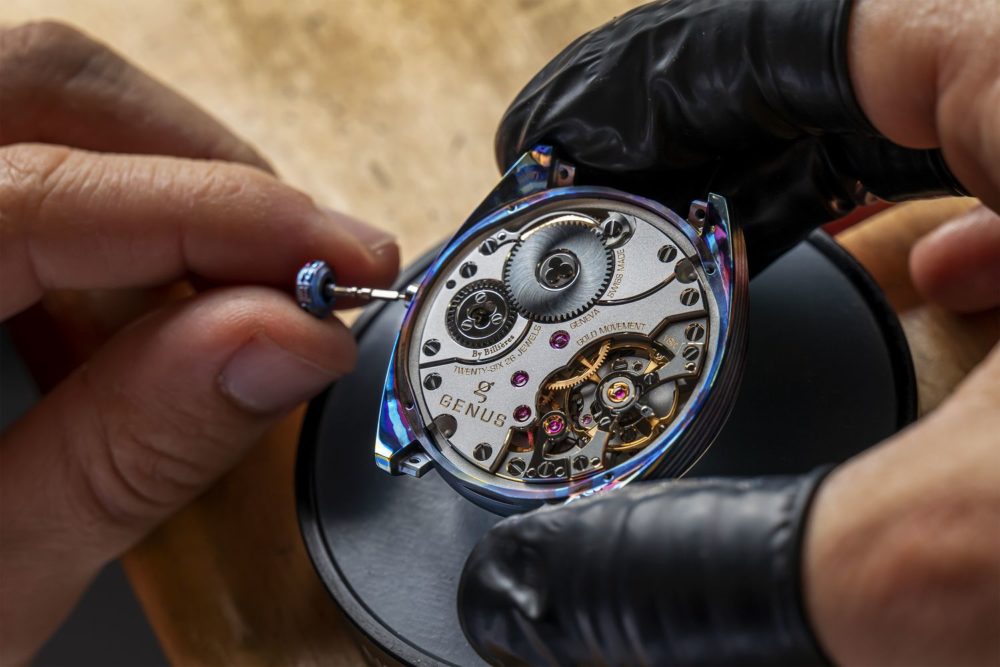Genus GNS1.2 TD: a damascene moment of ever-changing hours and hues
After inventing a new way of telling time, without dials or hands, Genus introduces a timepiece in Damascene Titanium. Share
The GENUS GNS1.2 TD is carved from a block of Damascene Titanium, the work of expert metalsmithing. Thus, the complex representation of time in flux belonging to GENUS finds itself echoed by the moiré, undulating, changing appearance where colour nuances make each piece unique by the very nature of this craft. A fusion of ancestral technique and modern material, an association between creator and wearer – GENUS takes an approach to watchmaking that truly defies the conventional.
Thinking differently, combining creativity as well as singularity, leaving the beaten track, inventing instead of replicating, stretching the ingenious whilst ensuring precision, reliability, legibility and wearability: In 2019, GENUS opened the first chapter of its story with two remarkable timepieces, the GNS1.2 WG and the GNS1.2 RG. Ten years of research, two inventions and three years of development went into this watch. Two patents lay down the basic principles of the two innovative mechanisms that underpin this free-flowing time display.
One in rose gold, the other in white gold, both measuring 43 mm in diameter and 13.1 mm thick, featuring the calibre 160W-1.2 or 160R-1.2, a new movement consisting of 418 components, entirely created and manufactured by GENUS in their Geneva workshop. It is a movement characterised first and foremost by its novel complication for indicating time. No dial, no hands. GENUS quite simply invented an unprecedented way of telling time – the mechanism as dramatic performance.

The innovation behind this display complication and its underlying mechanism was imagined, technically, in a completely new and daring way. A new stone humbly brought to the edifice of Swiss horological heritage by the man who invented it, the Master watchmaker Sébastien Billières. An approach first rewarded by the recognition of his peers by the attribution of the prestigious and coveted Mechanical Exception Prize at the Grand Prix d’Horlogerie de Genève (GPHG) in 2019.
Twelve satellites, one for each hour. They make a complete revolution along the periphery of the movement, at the crystal’s edge, once every twelve hours. The fixed white arrow on the left, in front of which the satellites scroll, points to the current hour. To remain in the reading direction, the satellites re-orient themselves and pivot 90 degrees every 3 hours, i.e. four times. The hour numbers – moulded in SuperLuminova™ and affixed to the revolving time-indicating satellites – are the result of meticulous development and design.

Since the launch last year, the months have passed each other at a breath-taking pace, and nothing is the same anymore for the small, independent GENUS team – in much the same way that a GENUS watch is unlike any other existing timepiece.
A sentiment rendered even more concrete by the fact that in 2020, GENUS is presenting a new version of the GNS1.2 in a material virtually unheard of in watchmaking: damascene titanium. It is a new chapter in the GENUS story, in more ways than one. The presentation of the new watch is also the occasion for announcing the digital certification of all its timepieces, an effective and modern means of combating counterfeiting and guaranteeing authenticity for the owner of the timepiece throughout its lifetime.
A Damascene moment
In 2020, GENUS re-imagines the GNS by incorporating it in a new metal case. After white gold and rose gold, GENUS ventures into new territory for watchmaking with a damascened titanium case, hence the name GNS1.2 TD (Titane Damassé). Applying the Damascus smithing technique to titanium requires a rare savoir-faire. In fact, the skill is listed in the Inventory of Intangible Cultural Heritage in France.
It is craftsmanship elevated to art, true artisanship, the domain of only the best metalsmiths. It has similarities with the working method of Mokume-gane in Japan, where the method has been used for making katana sword blades since the early 17th century.

The art of damascening consists of forging sheets of metal layer by layer. After having been hammered, each sheet is folded back upon itself, and the operation is repeated as many times as necessary – one might say like preparing the laminated dough used for puff pastry.
This homogeneous ‘stacking’ of homogeneous layers, each one annealed between each fold, gives the material an entirely new, very particular aspect. Each incision, each bevel into the edge of the damascened metal reveals the strata, the shapes, the undulations, the unique character of each layer.
The difficult work, at the heart of the forge’s embers, of folding and layering is usually done with iron or steel for katana blades. Although 40% lighter, titanium is three times harder and can be forged at temperatures 300 degrees higher than for conventional watchmaking steel.

This makes the method, which remains largely manual, quite laborious, and complex. In addition, to further enrich the appearance of this basic material, GENUS works with layers of various titanium alloys, each of which exhibits a different tint and reaction to heat. The colourful effect is rendered even more visually arresting by the final heat treatment that determines the general tone of the metal block, along with its subtle differences in tints and hues.
Bespoke colours and contrasts
Each part of the GNS1.2 TD’s casing is cut at an angle to achieve a different, unique appearance. GENUS then works to coordinate the different parts that make up a watch. Here, the intimate relationship between GENUS and the wearer again comes into play. Indeed, the future owner is invited to attend the ‘damascene revelation’ by open flame at the GENUS workshop in Geneva and will be able to intervene directly in the colouring as well as decide on a particular surface finish: matte, satin or polished. Only the owner shall be privy to the secrets of the manufacturing process and the artisans’ skills.



